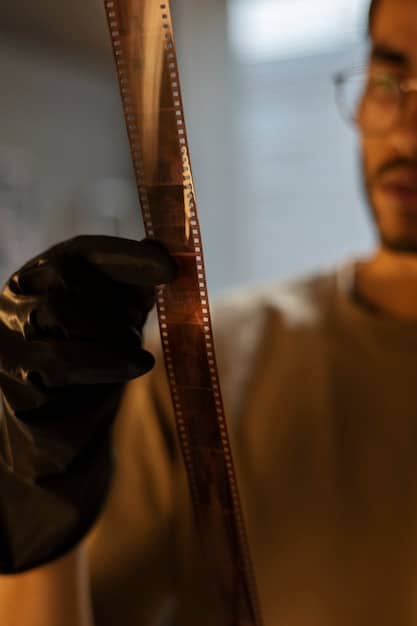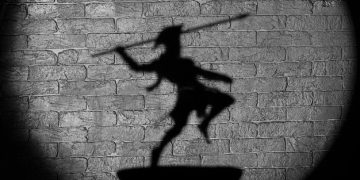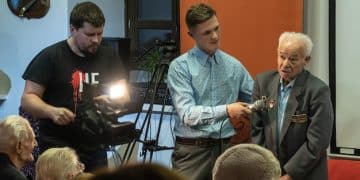Decoding Deleted Scenes: Editors Explain Cutting Room Decisions

Decoding the Deleted Scenes: Editors Share Why Key Moments End Up on the Cutting Room Floor reveals the intricate decision-making process behind film editing, where compelling narratives are shaped and sometimes ruthless choices are made to enhance pacing and impact.
Ever wondered why a scene you loved didn’t make the final cut of a movie? Decoding the Deleted Scenes: Editors Share Why Key Moments End Up on the Cutting Room Floor, revealing the secrets behind these tough decisions, offers a fascinating glimpse into the world of film editing.
The Editor’s Dilemma: Story vs. Spectacle
The editor’s role in filmmaking is often unseen but undeniably critical. They are the storytellers who piece together disparate shots and scenes into a cohesive narrative. However, sometimes a scene, even a good one, must be sacrificed for the greater good of the film. This tough decision-making process involves balancing various aspects of storytelling.
The process begins with the script, but quickly evolves as footage comes in. The editor reviews hours of takes, looking for emotional impact, clarity, and consistency. They assemble a rough cut, a preliminary version of the film, to see how everything flows. From there, the real work begins: refining pacing, cutting unnecessary dialogue, and even re-ordering scenes to maximize impact.
Pacing and Rhythm
One of the key considerations when cutting a scene is its effect on pacing. A scene might be beautifully acted and visually stunning, but if it slows down the narrative momentum or feels out of place, it’s likely to end up on the cutting room floor.
Character Arcs
Editors also have to consider whether a scene contributes to character development. If a scene doesn’t provide substantial insight into a character’s motivations or personality, it might be deemed expendable.
- Streamlining the Narrative: Sometimes a secondary subplot or character arc, though interesting, muddies the overall focus and gets removed.
- Maintaining Audience Engagement: Scenes that are too exposition-heavy or feel repetitive can bore audiences and are often cut to keep the movie engaging.
- Enhancing Emotional Impact: A well-placed cut can amplify the emotional resonance of a scene by removing distractions or focusing on key reactions.
Ultimately, editors strive to create an experience that captivates the audience from opening to closing credits. They consider the story’s core and are willing to make bold cuts to ensure that core shines through.

The Art of the Cut: How Scenes Are Judged
Evaluating a scene’s worth involves several critical factors. Editors collaborate closely with directors, producers, and even test audiences, but the final decision often comes down to a combination of objective measures and subjective artistic judgment. A scene can have great individual merit but still fail to serve the film as a whole.
One of the essential tools in an editor’s arsenal is feedback from test screenings. Audiences provide immediate reactions, highlighting moments that resonate and those that fall flat. This feedback is invaluable in identifying scenes that may not be working as intended.
The Screenplay’s Intent
A return to the screenplay is frequently useful. Was the scene important for later events? Has anything changed during production, which makes the scene redundant?
Budget and Time Constraints
Practical issues, such as budget overruns and time constraints, can also influence editing decisions. Sometimes, a well-crafted scene is cut simply because it adds too much to the film’s length or cost.
- Plot Relevance: Does the scene advance the main plot or provide essential background information?
- Emotional Resonance: Does the scene evoke the desired emotional response from the audience?
- Pacing Contribution: Does the scene maintain the film’s momentum, or does it feel like a drag?
Scenes are evaluated on how they advance the narrative while maintaining emotional resonance and pacing. These judgments are made in collaboration with other key stakeholders, offering a complete movie.
Director’s Vision vs. Editor’s Interpretation
The director typically has a clear vision for their film. This vision is developed from the initial concept to the completed picture. However, the editor brings their own creative input, so sometimes conflict arises. Editors must balance respecting the original vision with their own interpretation, especially when decisions differ.
This dynamic can be challenging but also incredibly rewarding. A good editor can offer a fresh perspective, identifying areas where the film can be improved or made more impactful. The key is open communication and mutual respect.
Finding Common Ground
Compromises must be made. This may mean finding an alternative way to convey information or cutting less crucial aspects of the scene.
Advocating for the Story
If an editor truly believes that a scene is essential to the film’s narrative, they must be able to articulate their reasoning to the director and other stakeholders.
- Open Dialogue: Establishing clear and respectful communication channels from the outset.
- Trust and Collaboration: Fostering a collaborative environment where everyone feels comfortable sharing ideas and concerns.
- Objective Evaluation: Focusing on the overall impact of a scene on the film, rather than personal preferences.
Directors and editors must learn to collaborate and compromise, finding that balance between vision and interpretation that serves the story best. Respectful communication and mutual trust are essential.
When Actors Object: Dealing with Creative Differences
Actors may strongly feel about their scenes, as they pour their heart and soul into their performances. It can be disheartening for an actor to discover that their hard work has been cut from the final film. This often leads to difficult conversations and requires a delicate approach.
Handling creative differences with actors requires empathy, transparency, and professionalism. Directors and editors must be prepared to explain the reasoning behind their decisions, while also acknowledging the actor’s feelings and contributions.
Explaining the Rationale
Emphasize that the scene’s removal is not a reflection of their performance, but rather a strategic decision to benefit the film as a whole.
Offering Alternatives
If feasible, consider including the deleted scene as a bonus feature on the film’s home release. This can provide actors with a sense of closure and allow audiences to see their work.

- Empathy and Understanding: Acknowledge the actor’s emotional investment in their role and the potential disappointment of having a scene cut.
- Clear Communication: Provide a clear and honest explanation of why the scene was cut, focusing on the film’s overall narrative and pacing.
- Professionalism and Respect: Maintain a respectful and professional demeanor, even in the face of disagreement.
Directors and editors must approach these situations with sensitivity and honesty, always remembering that actors are valuable collaborators who deserve respect and consideration.
The Role of Studio Executives: Balancing Art and Commerce
Studio executives often have the final say in determining what makes it into the final cut. Their decisions are usually driven by commercial considerations. Studio executives are responsible for ensuring that the film is financially successful. This can sometimes result in clashes between artistic vision and commercial viability.
Navigating these conflicting interests requires a delicate balance. Studio executives must be willing to trust the creative team’s vision and expertise. They must be clear with the creators, ensuring that everyone understands the commercial realities and makes informed decisions.
Marketing Considerations
A studio might cut a scene that is not easily marketable or does not align with the film’s overall branding, even if it tells an important part of the movie.
Test Audience Feedback
Studios pay for extensive test screenings and focus groups to gauge audience reaction. Feedback is sometimes directly at odds with what creators want.
- Data-Driven Insights: Executives have access to extensive data on audience preferences and market trends that can inform their decisions.
- Clear Communication: Open dialogue between the creative team and studio executives is essential for understanding each other’s priorities and concerns.
- Finding Common Ground: Exploring creative solutions that satisfy both artistic and commercial objectives.
Collaboration and understanding are key, ensuring that the film strikes a balance between being commercially viable and artistically fulfilling.
Deleted Scenes That Should Have Stayed
While many deleted scenes are justifiably cut, some have become legendary for their quality and contribution to the overall story. These scenes often provide valuable character development, plot exposition, or emotional resonance that is missed in the final cut.
One famous example is the extended sequence in “Almost Famous” where the band members reconcile after a fight.
There are numerous examples of deleted scenes that arguably enhanced the films they were intended for. These scenes often add depth and nuance to the story, providing insights into character motivations or exploring themes that were underdeveloped in the final cut.
The Fan Perspective
Fan reactions to deleted scenes are often quite strong. In the age of social media and online communities, fans can easily share their opinions and advocate for the inclusion of deleted scenes in future releases.
Director’s Cuts and Restorations
The desire to include important scenes often leads to the release of director’s cuts or restored versions of films. These versions provide a glimpse into the original vision and allow fans to experience the film as it was intended.
- Character Depth: Exploring the motivations and backstories of key characters.
- Plot Clarity: Offering additional exposition or context to complex storylines.
- Emotional Impact: Evoking stronger emotional responses from the audience.
While editorial choices can be difficult, these examples demonstrate the value of carefully considering the potential impact of each scene on the final product.
| Key Aspect | Brief Description |
|---|---|
| 🎬 Pacing | Scenes impacting film flow are often cut. |
| 🎭 Character Arcs | Scenes must significantly develop characters. |
| 💰 Budget | Cost overruns can force difficult scene cuts. |
| 🤝 Creative Differences | Editors balance vision, interpretation, and feedback. |
Frequently Asked Questions
▼
Scenes are often cut to improve pacing, streamline the narrative, or enhance emotional impact. Sometimes scenes don’t resonate well with test audiences or may not fit the film’s overall budget and length constraints.
▼
The final decision typically rests with a collaborative effort between the film’s director, editor, and studio executives. Each party brings different perspectives and priorities to the table.
▼
Some actors are disappointed when their scenes are cut, as they invest significant time and emotion into their performances. It’s important for directors and editors to communicate these decisions with empathy and transparency.
▼
Yes, many deleted scenes are included as bonus features on DVD, Blu-ray, and streaming platforms. These offer viewers a glimpse into aspects of the film that didn’t make the final cut.
▼
Yes, studio executives are often involved, balancing creative vision. They ensure its commercial viability. They may suggest cuts for marketing purposes, based on data analysis of test screenings.
Conclusion
Ultimately, the decision to cut a scene is a complex one, influenced by a multitude of factors ranging from pacing and plot to budget and audience reaction. By understanding these considerations, we can gain a greater appreciation for the art of film editing and the pivotal role it plays in shaping the stories we see on screen.





